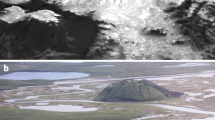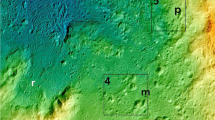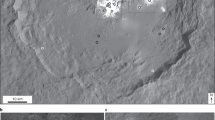Abstract
Five decades of observations of Ceres suggest that the dwarf planet has a composition similar to carbonaceous meteorites and may have an ice-rich outer shell protected by a silicate layer. NASA’s Dawn spacecraft has detected ubiquitous clays, carbonates and other products of aqueous alteration across the surface of Ceres, but surprisingly it has directly observed water ice in only a few areas. Here we use Dawn Framing Camera observations to analyse lobate morphologies on Ceres’ surface and we infer the presence of ice in the upper few kilometres of Ceres. We identify three distinct lobate morphologies that we interpret as surface flows: thick tongue-shaped, furrowed flows on steep slopes; thin, spatulate flows on shallow slopes; and cuspate sheeted flows that appear fluidized. The shapes and aspect ratios of these flows are different from those of dry landslides—including those on ice-poor Vesta—but are morphologically similar to ice-rich flows on other bodies, indicating the involvement of ice. Based on the geomorphology and poleward increase in prevalence of these flows, we suggest that the shallow subsurface of Ceres is comprised of mixtures of silicates and ice, and that ice is most abundant near the poles.
This is a preview of subscription content, access via your institution
Access options
Access Nature and 54 other Nature Portfolio journals
Get Nature+, our best-value online-access subscription
$29.99 / 30 days
cancel any time
Subscribe to this journal
Receive 12 print issues and online access
$259.00 per year
only $21.58 per issue
Buy this article
- Purchase on Springer Link
- Instant access to full article PDF
Prices may be subject to local taxes which are calculated during checkout






Similar content being viewed by others
References
Lebofsky, L. A., Feierberg, M. A., Tokunaga, A. T., Larson, H. P. & Johnson, J. R. The 1.7- to 4.2-micron spectrum of asteroid 1 Ceres—evidence for structural water in clay minerals. Icarus 48, 453–459 (1981).
Rivkin, A. S. et al. in The Dawn Mission to Minor Planets 4 Vesta and 1 Ceres (eds Russell, C. T. & Raymond, C. R.) 95–116 (Springer, 2012).
De Sanctis, M. C. E. et al. Ammoniated phyllosilicates with a likely outer Solar System origin on (1) Ceres. Nature 528, 241–244 (2015).
Thomas, P. C. et al. Differentiation of the asteroid Ceres as revealed by its shape. Nature 437, 224–226 (2005).
McCord, T. B. & Sotin, C. Ceres: evolution and current state. J. Geophys. Res. 110, E05009 (2005).
Castillo-Rogez, J. C. & McCord, T. B. Ceres’ evolution and present state constrained by shape data. Icarus 205, 443–459 (2010).
Zolotov, M. Y. On the composition and differentiation of Ceres. Icarus 204, 183–193 (2009).
Park, R. S. et al. A partially differentiated interior for (1) Ceres deduced from its gravity field and shape. Nature 537, 515–517 (2016).
Prettyman, T. et al. Extensive water ice within Ceres’ aqueously altered regolith: evidence from nuclear spectroscopy. Science 15, aah6765 (2016).
A’Hearn, M. F. & Feldman, P. D. Water vaporization on Ceres. Icarus 98, 54–60 (1992).
Küppers, M. et al. Localized sources of water vapour on the dwarf planet (1) Ceres. Nature 505, 525–527 (2014).
Nathues, A. et al. Sublimation in bright spots on (1) Ceres. Nature 528, 237–240 (2015).
Combe, J.-P. et al. Detection of local H2O exposed at the surface of Ceres. Science 353, aaf3010 (2016).
Sierks, H. et al. The Dawn Framing Camera. Space Sci. Rev. 163, 263–327 (2011).
Hiesinger, H. et al. Cratering on dwarf planet Ceres: implications for its interior and evolution. Science 353, aaf4759 (2016).
Buzckowski, D. et al. The geomorphology of Ceres. Science 353, aaf4332 (2016).
Bland, M. T. et al. Composition and structure of the shallow subsurface of Ceres as revealed by crater morphology. Nat. Geosci. 9, 538–542 (2016).
Fanaleand, F. P. & Salvail, J. R. The water regime of Asteroid (1) Ceres. Icarus 82, 97–110 (1989).
Schorghofer, N. The lifetime of ice on Main Belt Asteroids. Astrophys. J. 682, 697–705 (2008).
Hayne, P. O. & Aharonson, O. Thermal stability of ice on Ceres with rough topography. J. Geophys. Res. 120, 1567–1584 (2015).
Krohn, K. et al. Mass movement on Vesta at steep scarps and crater rims. Icarus 244, 120–132 (2014).
Singer, K. N., McKinnon, W. B., Schenk, P. M. & Moore, J. M. Massive ice avalanches on Iapetus mobilized by friction reduction during flash heating. Nat. Geosci. 5, 574–578 (2012).
Malin, M. C. Mass movements on Venus: preliminary results from Magellan cycle 1 observations. J. Geophys. Res. 97, 16337–16352 (1992).
Holt, J. et al. Radar sounding evidence for buried glaciers in the southern mid-latitudes of Mars. Science 322, 1235–1238 (2008).
Lucchitta, B. K. Valles Marineris, Mars, wet debris flows and ground ice. Icarus 72, 411–429 (1987).
DeBlassio, F. V. Landslides in Valles Marineris (Mars): a possible role of basal lubrication by sub-surface ice. Planet. Space Sci. 59, 1384–1392 (2011).
Haeberli, W. et al. Permafrost creep and rock glacier dynamics. Perm. Periglac. Process. 17, 189–214 (2006).
White, S. E. Rock glaciers and block fields, review and new data. Quart. Res. 6, 77–97 (1976).
Humlum, O. The geomorphic significance of rock glaciers: estimates of rock glacier debris volumes and headwall recession rates in West Greenland. Geomorphology 35, 41–67 (2000).
Mouginis-Mark, P. Ejecta emplacement and modes of formation of martian fluidized ejecta craters. Icarus 45, 60–76 (1981).
Senft, L. E. & Stewart, S. T. Impact crater formation in icy layered terrains on Mars. Met. Planet. Sci. 43, 1993–2013 (2008).
Boyce, J., Barlow, N., Mouginis-Mark, P. & Stewart, S. Rampart craters on Ganymede: their implications for fluidized ejecta emplacement. Met. Planet. Sci. 45, 638–661 (2010).
Legros, F. The mobility of long-runout landslides. Eng. Geol. 63, 301–331 (2002).
Ancey, C. Plasticity and geophysical flows: a review. J. Non-Newton. Fluid Mech. 142, 4–35 (2007).
Weertman, J. Creep deformation of ice. Annu. Rev. Earth Planet. Sci. 11, 215–240 (1983).
Durham, W. B., Kirby, S. H. & Stern, L. A. Creep of water ices at planetary conditions: a compilation. J. Geophys. Res. 102, 16293–16302 (1997).
Watkins, J. A., Ehlmann, B. L. & Yin, A. Long-runout landslides and the long-lasting effects of early water activity on Mars. Geology 43, 107–110 (2015).
Marchi, S. et al. High-velocity collisions from the lunar cataclysm recorded in asteroidal meteorites. Nat. Geosci. 6, 307 (2013).
Acknowledgements
The authors recognize the incredible efforts of the full Dawn science and operations teams. Dawn’s mission is managed by JPL for NASA’s Science Mission Directorate in Washington. Dawn is a project of the directorate’s Discovery Program, managed by NASA’s Marshall Space Flight Center in Huntsville, Alabama. UCLA is responsible for overall Dawn mission science. Orbital ATK Inc., in Dulles, Virginia, designed and built the spacecraft. The German Aerospace Center, Max Planck Institute for Solar System Research, Italian Space Agency and Italian National Astrophysical Institute are international partners on the mission team.
Author information
Authors and Affiliations
Contributions
B.E.S. conceived of the paper, organized the Dawn Ground Ice working group, wrote the paper, and is an associate of the Dawn Framing Camera Team. K.H.G.H., H.T.C., J.E.C.S., T.P. and J.D.L. analysed images and provided figures. A.N. leads the Dawn Framing Camera team. The remaining authors planned observations, provided discussion and/or analysis, and helped revise the paper.
Corresponding author
Ethics declarations
Competing interests
The authors declare no competing financial interests.
Supplementary information
Supplementary Information
Supplementary Information (PDF 2008 kb)
Rights and permissions
About this article
Cite this article
Schmidt, B., Hughson, K., Chilton, H. et al. Geomorphological evidence for ground ice on dwarf planet Ceres. Nature Geosci 10, 338–343 (2017). https://doi.org/10.1038/ngeo2936
Received:
Accepted:
Published:
Issue Date:
DOI: https://doi.org/10.1038/ngeo2936
This article is cited by
-
Brine residues and organics in the Urvara basin on Ceres
Nature Communications (2022)
-
Dwarf planet (1) Ceres surface bluing due to high porosity resulting from sublimation
Nature Communications (2021)
-
GAUSS - genesis of asteroids and evolution of the solar system
Experimental Astronomy (2021)
-
Longitudinal ridges imparted by high-speed granular flow mechanisms in martian landslides
Nature Communications (2019)
-
Dome formation on Ceres by solid-state flow analogous to terrestrial salt tectonics
Nature Geoscience (2019)



